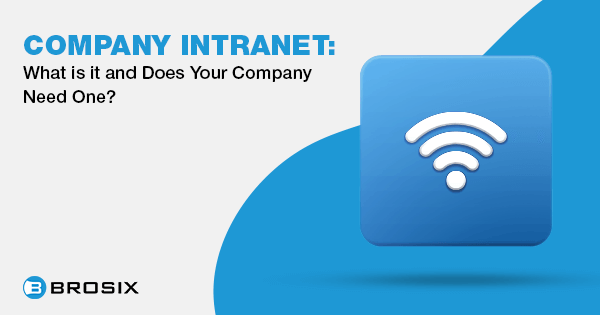As companies have grown and diversified, managing all of these aspects of corporate life has become more complicated. To keep everything running smoothly and to maintain employee engagement across an entire organization, a solution was devised—the company intranet.
A company intranet is a private network, website, or digital area used for internal communications, storing essential data, and fostering collaboration.
Now we’ll talk about what a company intranet is, whether your company needs one, and how the best company intranet should look. We’ll also give you a sneak peek at how our own company intranet solution works.
What Is a Company Intranet?
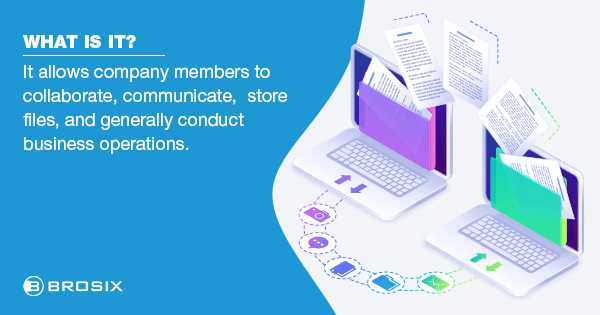
A company intranet is a business’ walled-off network of sorts that allows company members to collaborate, communicate, store files, and generally conduct business operations.
Companies need a separate, private space for a variety of reasons. Other tools are often inadequate at providing all the features a business might need, and their security might not be adequate. We all live and work in a highly competitive world where ill-timed leaks or corporate espionage can severely impact a company’s bottom line.
Company intranets are much more than simple private chat rooms. They help connect workers, especially remote employees, in a singular digital workspace, fostering cohesion on both a personal and professional level.
Types of Company Intranet Software
Intranet solutions have evolved significantly over time, bringing in more valuable features and flexibility as they’ve developed.
Traditional intranet
Traditional intranets were pretty limiting. At first, they were usable only by office employees, meaning that the intranet was only accessible via (office) computers. This is expected as other internet-ready devices weren’t as developed back then as they are now.
Furthermore, they are characterized by one-way communication and, oftentimes, an outdated interface and almost no personalization.
As the way we work has changed dramatically, especially in the last years due to the pandemic, this would’ve been a significant problem. Hybrid work is the name of the game now, and many employees work remotely at least some of the time. So, social intranet emerged.
Social intranet
A social, or modern, intranet solution is a tool that brings employees together, allowing them to share and discuss ideas through comments, likes, and posts.
Nowadays, this kind of network can be used by employees remotely, wherever they might be. Additionally, new intranets can be accessed via smartphones, tablets, or laptops, allowing employees to use the intranet on the go.
Company Intranet vs Slack and Other Messaging Platforms
When you read about company intranet software, you might immediately think of Slack, Microsoft Teams, and other top-rated business messaging solutions. However, there are significant differences between these platforms and an intranet solution.
Communication tools like Slack are meant for fast, short conversations. Slack comes with file storage and numerous integrations that can help increase employee engagement and encourage employees to cooperate.
However, most of Slack’s focus is on rapid communication, mainly designed to avoid endless emailing. Finding files and previous conversations on Slack can be headache-inducing, with no proper way to structure and organize all that information. On the other hand, a modern intranet is a permanent solution for handling all critical information and data within an entire company. Here’s how it works:
- Company intranet software allows you to organize information quickly and painlessly. These tools are built precisely for this purpose, letting you structure and fetch data as you please. You don’t want to waste precious time digging up that one file from a 3-month-old conversation—you need it right now, and a corporate intranet lets you get it in seconds.
- A modern company intranet allows for efficient, professional communication among teammates. Anyone who has ever used Slack knows that it’s often well-deserved of its name, where you can quickly spiral into sending cute cat pictures while important information gets buried deeper and deeper. The intranet structure does not allow for fun, informal communication—far from it, but it’s also way better at letting members successfully convey important company information.
- Tools like MS Teams provide some customization, but it’s primarily surface-level and cosmetic—you still have to work within a pretty rigid framework. However, a business intranet is significantly more customizable and allows for things like creating detailed user profiles.
These features are great for motivating employees to communicate and become engaged. They can also help you get to know your colleagues better and become a more close-knit crew.
Software like Slack is still beneficial and is often used in conjunction with a company intranet. Still, it’s essential to know that they have distinct capabilities and uses.
What Is a Company Intranet Used For?
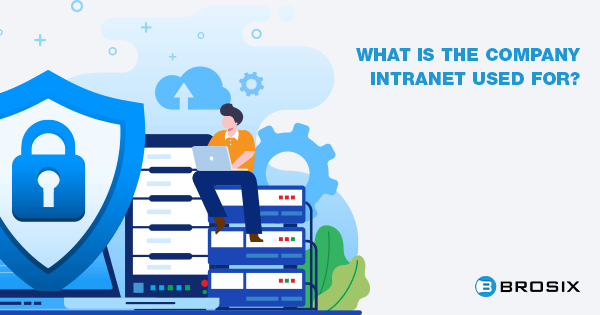
Depending on their use, the three main types of intranet are collaborative, communications, and knowledge management.
Now, let’s take a closer look at what exactly intranet platforms are used for:
- Secure internal communication between employees
- File and document management
- Fostering communication and engagement
- Building and developing a solid company culture
- Helping with collaboration across the entire workforce
- Boosting productivity and streamlining business processes
Let’s dissect each use case one by one and see how a corporate intranet can help your business in each of these areas.
Internal communication
One of the core features of company intranet software is to allow secure internal communication. As you well know, quick and efficient communication is critical for running a successful business.
Most intranets come equipped with instant real-time messaging that allows you to reach out to team members or other departments quickly.
The benefits of using an intranet for international corporations or remote teams are evident here, but even 100% of on-site companies stand to gain a lot. Instead of wasting time on endless meetings and unnecessary emails, you can use an intranet page to share important information or send files in an instant.
This is not the only type of communication offered by a corporate intranet. They also feature news feeds and announcements, allowing employees or management to spread important information quickly. These can include things like launch updates, new work rules, changes in approach, etc.
Lastly, intranet software helps keep internal communications private from prying eyes. This is a crucial aspect of any intranet solution. Your company not only stands to lose profits when some information gets leaked, but there might be legal repercussions if any sensitive user data is made public.
File storage and management
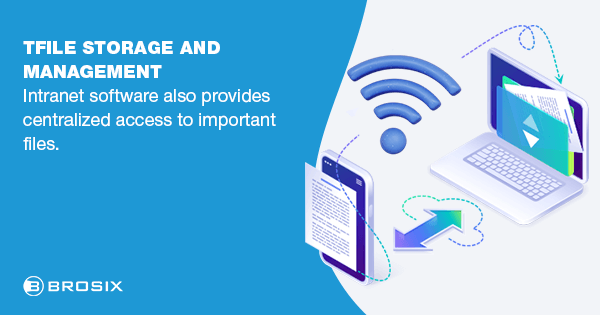
The intranet is a central hub for storing all essential company data. Companies amass a considerable number of files over time, and you’ll need a place to store them all safely.
All employees have access to any information they need. Additionally, intranet solutions let companies structure and sort stored data, allowing easy file filtering and searching, saving precious time. Instead of digging through a pile of hundreds of files, you can sort them by type, name, date accessed, and so forth.
Files aren’t the only thing stored on the intranet. It also contains other information employees need, such as chat history and a helpful knowledge base.
Fostering engagement
Keeping employees engaged is much more complicated when everyone’s apart and working remotely. Coupled with the mental toll the pandemic took on all of us, keeping everyone lively and communicative has become very difficult.
[highlight_block title=”These are the best remote work software tools to use.” link1=”https://www.brosix.com/blog/best-remote-work-software-tools/” link2=”” link3=”” ]
Through intranet communication tools, senior management can keep workers engaged more quickly.
One of the main ways to achieve this is by giving employees a voice and proper channels through which to express their opinions. An intranet’s various communication channels can help a lot here. They give team members a place to express direct feedback, provide new ideas, voice concerns, or talk about the problems they might face (and share those cute cat pictures).
Features such as social feeds, employee recognition programs, and feedback channels also contribute to higher engagement levels.
Building company culture
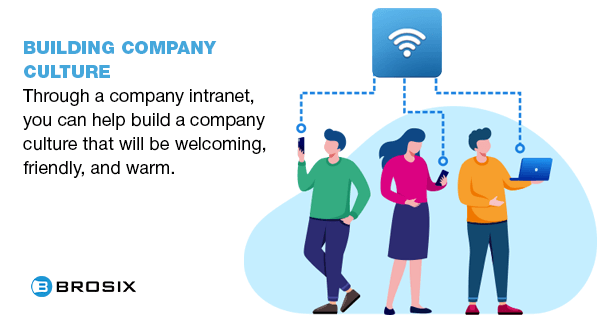
An often overlooked aspect of corporate life is building a healthy company culture. As we talked about initially, companies are now much more than simple groups of people connected by business interests. They’re living, breathing communities, and they react to the environment around them.
Through a company intranet site, you can help build a company culture that will be welcoming, friendly, and warm. This is sure to make team members happier and also increase productivity. Especially in an entirely digital workplace, where organizing things like team building can be difficult, you’ll need all the tools at your disposal to create a company culture that connects.
Numerous social features, coupled with plentiful integrations, are an excellent way to achieve this, and a company intranet comes with all of that. Workers can talk, have fun, and truly become part of a community.
Fostering collaboration
Practically all of the company intranet features we mentioned above help, one way or another, with fostering collaboration between employees and departments.
First, having an easy way to communicate—both with your team members and across different departments—aids employees to work together. Instead of going through management or sending countless emails, you can just reach out through the intranet website and get things done.
[highlight_block title=”Check out the 43+ best collaboration tools around.” link1=”https://www.brosix.com/blog/collaboration-apps/” link2=”” link3=”” ]
A unified communications hub also helps employees pitch ideas or give feedback quickly, leading to exciting new developments or improvements to your product or service. Additionally, with file-sharing being easy in a good intranet, you can promptly send essential documents and blueprints back and forth. This removes the endless waiting for them to be faxed or emailed.
Through the intranet, even fully remote teams can work together without hiccups and slowdowns, all from the comfort of their homes.
Boosting productivity and streamlining work processes
Lastly, intranets serve to improve your company’s overall productivity and streamline essential business processes.
Important company news and updates can be quickly sent out, keeping everyone in the loop. File sharing and messaging make communication and collaboration painless. Employee directories make the job easier for HR departments and company leadership while helping workers connect and improve new hires’ employee experience.
[highlight_block title=”Here are the best productivity apps to use now.” link1=”https://www.brosix.com/blog/productivity-apps/” link2=”” link3=”” ]
On top of that, intranets function as Content Management Systems as well, which makes content creation and collaboration much easier.
All in all, a company intranet’s features help to massively improve productivity by optimizing and speeding up otherwise lengthy tasks.
Company Intranet Solutions: Benefits and Limitations
When you consider using an intranet for your business, you must weigh the pros and cons first.
Let us summarize them for you.
| Benefits | Limitations |
| Improved communication, which facilitates smoother collaboration across departments. | Some intranet platforms can be challenging to navigate, especially for less tech-savvy employees. |
| The employee intranet can serve as a central hub for accessing organizational resources, making key documents and information readily available. | Remote employees may experience difficulty accessing the intranet, limiting their flexibility and efficiency. |
| Allows employees to share standard operating procedures, templates, forms, and policies, helping everyone stay aligned. | Mobile access is often limited or unavailable, making it harder for employees to stay connected when away from their primary workspace. |
| Consolidates tools and resources in one place, saving time on redundant activities and helping employees focus on higher-impact work. | Information updates may not occur in real time, which can result in employees relying on outdated data. |
| Centralizes information to reduce time spent on administrative tasks. | Limited search features can make locating specific documents challenging, leading to wasted time. |
Choosing the Right Company Intranet
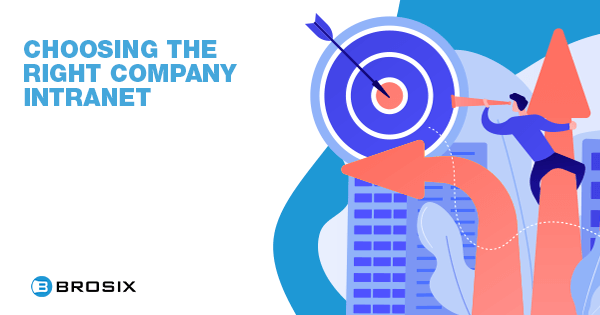
As we’ve discussed the drawbacks and benefits of a company intranet, you’re left with the task of picking the best company intranet software for your business. There are plenty of options out there, so it might be challenging to pick one.
To help you out, here are the main features and capabilities you should look for in a company intranet portal.
- Mobile app and multi-platform availability
- Ease of use
- Robust file sharing
- Multi-channel communication
- Plentiful integrations
- Cloud access
- Customizability
- Top-notch security
Luckily, you can find all of these features and more right here at Brosix! Our secure instant messaging platform is much more than a simple communication tool—it comes with its private team network, which has all the features you might look for in a company intranet and more.
Increase Employee Engagement With Brosix Private Team Network
The Brosix private team network is just one of the many features of our messaging platform. It’s feature-packed with useful tools that allow you to manage how your team collaborates and communicates, boosting productivity. It’s like a supercharged company’s intranet that boasts a vast number of additional sound tools.
First of all, our private team network—and our platform as a whole—comes with military-grade security. It allows managers and administrators to set permissions for file access, view user activity (and set its deletion times), and even comes with its own antivirus system, preventing any malware from sneaking in.
Besides being protected from malware, all files and communication passing through the network are protected by high-level encryption, preventing spying from malicious third parties. Admins can also control who each employee can communicate with within the digital workplace, preventing unauthorized or unproductive communication.
The private team network comes with a high level of customizability. Via the Web Control Panel, administrators can toggle features for individual users at will.
File sharing is also easy with Brosix, as you can quickly send files of unlimited size to any authorized contact on the network. Files are automatically compressed and shared through P2P, meaning they get sent out faster and with less bandwidth used.
You won’t have any issues with collaboration either. Besides file sharing, our platform comes with screenshot sending and screen sharing. This allows for easy collaboration and seamless onboarding of new hires.
Of course, this is a messaging platform, after all, so you’ll have access to practically all channels of communication. This includes instant chat and chat rooms and both audio and video calls. This brings a tremendous amount of flexibility, as you can manage group projects, organize one-on-one meetings, or just quickly convey important information between users.
Company-wide announcements are also easy to make thanks to our broadcast message feature. Don’t worry; employees who are traveling or can’t access their computers won’t miss out on anything important, as our Brosix mobile app comes with all the messaging features.
All in all, if you’re looking for the best company intranet solution, you can try out our platform for free, with no credit card required.
Conclusion
That’s it. Hopefully, now you have a much better understanding of what a company intranet is, what benefits it brings, and how to find the best company intranet out there. We also presented our solution that can go toe-to-toe (or even outperform) the top modern intranets around.
We definitely recommend getting a company intranet for your business, as it will result in better productivity and collaboration across the board, all without breaking the bank.
FAQ
What are some examples of company intranet platforms?
Some company intranet examples include Microsoft SharePoint, Confluence, and Google Workspace. These platforms offer various features tailored to enhance intranet functionality and user experience.
What are some common intranet best practices?
Common intranet best practices include regularly updating content, ensuring mobile compatibility, encouraging employee contributions, promoting the use of the intranet for collaboration, and measuring engagement to continuously improve the platform.
Can an intranet help with project management in HR?
Yes, an intranet can assist in project management within HR by providing tools for collaboration, document sharing, and communication. HR teams can use project management software integrated with the intranet to track progress and ensure all employees know their roles and responsibilities in various initiatives.
What is the difference between an intranet and an extranet?
An intranet is a private network accessible only to employees of a company, while an extranet extends access to selected external users, such as partners or clients. This distinction allows organizations to share information securely with both internal and external stakeholders when necessary.
What features should be included in a modern social intranet?
A modern social intranet should include features such as user profiles, activity feeds, document-sharing capabilities, discussion boards, and integration with other workplace tools. Using a social intranet enhances collaboration and fosters a sense of community among employees.
What should companies consider if they choose to design their intranet?
Companies should consider their employees’ needs, the types of content to be shared, and the desired features when designing their intranet. Additionally, it is crucial to ensure the intranet is user-friendly and aligned with company goals to maximize employee engagement and satisfaction.
How does intranet design affect employee engagement?
Intranet design significantly impacts employee engagement by making information easily accessible and visually appealing. A user-friendly intranet site encourages employees to use the intranet regularly, ensuring they are informed and engaged with company initiatives. Key intranet features should include intuitive navigation, quick access to resources, and a responsive layout.
